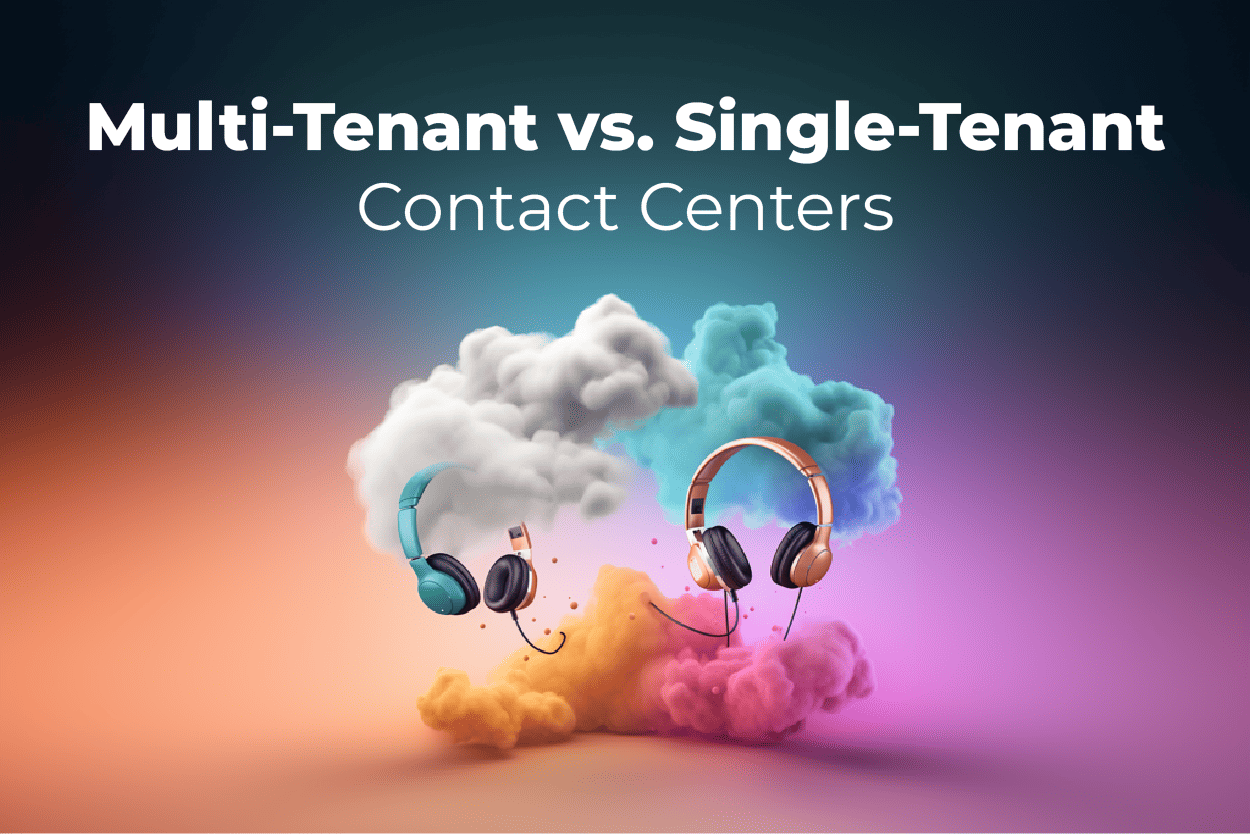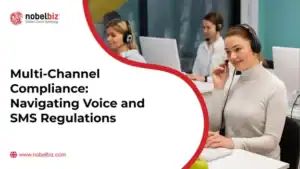In the realm of Contact Center as a Service (CCaaS) solutions, the choice between multi-tenant and single-tenant contact centers carries profound implications for businesses. While both models promise similar features, their underlying infrastructure and advantages diverge significantly. In this article, we delve into the intricacies of multi-tenant and single-tenant contact centers, shedding light on the key differentiators that can inform your decision and elevate your contact center operations to new heights.
In theory, all CCaaS solutions are designed to run and operate contact center businesses and departments effectively and productively. In practice, this is easier said than done. At first glance, all CCaaS solutions promise more or less the same features and technical capabilities. However, there are key differentiators that you might want to consider before committing to one or another. And one critical but often overlooked aspect is the hosting model.
The general difference between multi-tenant and single-tenant
Because the CCaaS scene is inundated by the multi-tenant model, few are those who understand the difference between these two hosting models.
 Multi-tenant contact centers are like shared apartment buildings, where multiple tenants or customers share the same software platform and resources. Each tenant operates independently within the shared environment, but they all use the same underlying infrastructure. This setup allows for cost-effectiveness and scalability, as resources are efficiently shared among multiple users.
Multi-tenant contact centers are like shared apartment buildings, where multiple tenants or customers share the same software platform and resources. Each tenant operates independently within the shared environment, but they all use the same underlying infrastructure. This setup allows for cost-effectiveness and scalability, as resources are efficiently shared among multiple users.
On the other hand, single-tenant contact centers are more like owning a standalone house; each customer has a dedicated instance of the software and infrastructure. This exclusive setup offers greater control and customization but can be less cost-efficient, as resources are not shared among multiple tenants.
The model you choose will directly impact your operations
The difference between multi-tenant and single-tenant contact centers is essential for a contact center business because it directly impacts various aspects of their operations and offerings:
Cost Efficiency
Multi-tenant contact centers are generally more cost-effective since resources are shared among multiple customers. This allows the service provider to achieve economies of scale, reducing operational costs and making the service more affordable for clients. On the other hand, single-tenant setups can be more expensive, as each customer requires dedicated resources and infrastructure.
Scalability
Multi-tenant contact centers offer better scalability since resources can be dynamically allocated based on the changing needs of multiple clients. As the customer base grows or contracts, the shared infrastructure can easily adapt to accommodate the changes. Single-tenant setups might face challenges in handling sudden growth or accommodating fluctuations in demand since each client has an isolated environment.
Flexibility
Multi-tenant contact centers often provide standardized solutions that cater to the needs of a diverse customer base. This allows for quick deployment and reduced setup times. Single-tenant setups, however, offer more flexibility in terms of customization to meet specific client requirements, but this might also lead to longer implementation times and higher costs.
Maintenance and Upgrades
Multi-tenant contact centers benefit from centralized maintenance and updates. When the service provider upgrades the software or fixes issues, all tenants can enjoy the improvements simultaneously. In contrast, single-tenant setups might require individual maintenance and upgrades for each client, which can be time-consuming and resource-intensive.
Security and Isolation
Single-tenant contact centers offer a higher level of data isolation and security, as each client’s data is kept separate from others. This can be crucial for businesses with strict security and compliance requirements. Multi-tenant setups employ measures to ensure data separation and security as well, but the risk of data co-mingling may be a concern for some businesses.
Time-to-Market
Multi-tenant contact centers often have a faster time-to-market for new features and enhancements since they only need to be implemented once for all tenants. Single-tenant setups may experience delays in deploying new features, as they require individual implementations for each customer.
Finding the Right Fit
The single-tenant contact center model is well-suited for businesses that require a high degree of customization and have specific security, reporting, and compliance needs. These businesses typically deal with sensitive data, such as healthcare providers, financial institutions, government agencies and so on. With a single-tenant setup, they can have exclusive control over their infrastructure, ensuring data isolation and meeting stringent regulatory requirements.
On the other hand, the multi-tenant contact center model is ideal for businesses that prioritize cost-effectiveness, scalability, and rapid deployment. It suits companies with less specialized requirements, where standardized solutions can cater to a broad customer base. E-commerce platforms, startups, and small to medium-sized enterprises often benefit from the shared resources and efficient scaling capabilities of a multi-tenant environment, allowing them to focus on their core operations without significant upfront costs.
| Characteristic | Multi-Tenant Contact Centers | Single-Tenant Contact Centers |
|---|---|---|
| Resource Sharing | Shared infrastructure and resources | Dedicated resources and infrastructure |
| Scalability | Limited customization, but scales easily for smaller needs | Highly customizable scaling |
| Performance | Performance may be affected by other tenants' activities | Complete separation of resources allows for best possible performance and throughput |
| Customization | Limited customization options for individual requirements | Single-tenant allows software vendors to deliver tailor made products, based on personalized customer needs |
| Maintenance | Centralized maintenance, updates affect all tenants | Independent maintenance, tailored updates for each tenant |
| Cost | Cost-effective due to shared expenses | Potentially higher cost but more control over resources (*NobelBiz keeps cost in check) |
| Real-Time Reporting | Limited real-time insights due to shared reporting | Immediate access to real-time data for accurate analysis |
| Customizable Reports and Analytics | Limited customization of reports and analytics | Flexibility to create and analyze reports as needed |
| Access to Database | Shared access, potential data security concerns | Exclusive database access, enhanced data security |
| Reliable Operations | Shared resources might lead to potential downtime | Since other users' activities can impact co-tenants, single-tenant architectures are considered much more reliable |
| Individual Upgrades | Upgrades may affect all tenants simultaneously | Upgrades tailored to individual center's requirements |
| Customized Solutions | Limited flexibility in offering custom solutions | Customized solutions to meet specific business needs |
| Migrating and Future-Proof Solutions | Limited ability to migrate or adapt for future technologies | Migrating singlet tenant applications is easier, because data of only one customer is involved |
Pricing Considerations
 When evaluating the hosting model for CCaaS solutions, pricing plays a critical role in the decision-making process. The majority of CCaaS providers lean towards multi-tenant environments, where multiple clients share the same software platform and resources. While this setup offers cost-effectiveness due to shared infrastructure and economies of scale, it’s essential to be aware of potential limitations.
When evaluating the hosting model for CCaaS solutions, pricing plays a critical role in the decision-making process. The majority of CCaaS providers lean towards multi-tenant environments, where multiple clients share the same software platform and resources. While this setup offers cost-effectiveness due to shared infrastructure and economies of scale, it’s essential to be aware of potential limitations.
Some providers may offer a seemingly exclusive option by allowing clients to “create their own domain,” but this approach still falls under the multi-tenant model. It’s crucial for businesses to thoroughly understand the actual level of exclusivity and resource allocation provided in such cases.
While multi-tenant environments may appear more budget-friendly upfront, it’s essential to consider the long-term implications regarding resource consumption.
Resource Consumption
As activity levels fluctuate throughout the day, the shared resources can become strained. But activity fluctuation is not the only problem. The majority of the CCaaS providers advertise their services as being “scalable and flexible”. In consequence, If one of your “cotenants” decides to upgrade their capacity, everyone else has to suffer, leading to:
- latency issues
- call quality problems
- increased wait times for customers
This trade-off between cost efficiency and performance can significantly impact customer experience, potentially leading to dissatisfied callers and reduced customer loyalty.
In contrast, the single-tenant model offers dedicated resources for each client, providing more control and predictability in resource consumption. With exclusive access to the infrastructure, businesses can better manage their resource allocation and ensure a consistent level of service even during demanding periods.
The NobelBiz Model: Single-Tenant for All Our Clients
At NobelBiz, we take pride in offering our OMNI+ clients a secure and exclusive solution through our individual dedicated cloud architectures, which are built on the reliable Amazon Web Services (AWS) infrastructure. Unlike our competitors, who often use multi-tenant environments, we prioritize data integrity and privacy by ensuring that each customer enjoys their own dedicated architecture.
This approach grants our clients complete control over their data and seamless integration, providing a personalized and tailored experience. With NobelBiz, you can rest assured that your valuable data is protected in a robust and secure environment tailored specifically to meet your unique business needs.

Andrei is an experienced marketing professional specializing in propelling growth for both B2B and B2C companies. Proficient in streamlining marketing operations and enhancing lead and customer experiences through SEO and marketing techniques.






